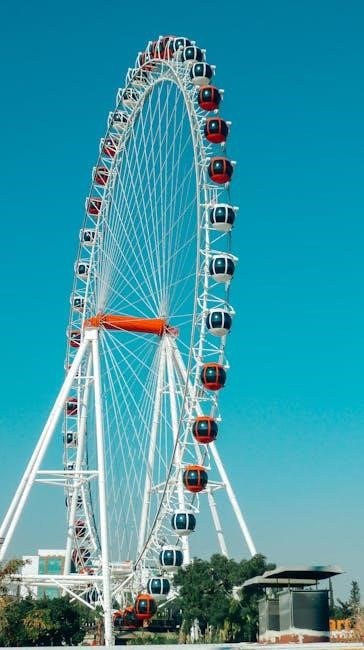Understanding Measurements
Accurate body measurements are crucial for determining the right size in big and tall clothing. Key measurements include chest, waist, inseam, and sleeve length. Use a flexible tape measure for precision, ensuring the best fit.
Why Accurate Measurements Are Essential
Accurate measurements are vital for ensuring the best fit in big and tall clothing. Ill-fitting garments can lead to discomfort, poor aesthetics, and increased return rates. Correct measurements help match body proportions to clothing sizes, reducing sizing guesswork. For big and tall individuals, precise chest, waist, and inseam measurements are critical due to varied body types. Standard size charts often fail to account for proportional differences, making personal measurements indispensable. Inaccurate sizing can result in sleeves or pant legs being too short or too long, compromising both style and functionality. By taking precise measurements, individuals can avoid these issues and select clothing that flatters their frame. This step is especially important for online shoppers who cannot try garments before purchase. Ultimately, accurate measurements ensure confidence, comfort, and a polished appearance, making them the foundation of a successful shopping experience for big and tall individuals.
Tools Needed for Measuring
To ensure accurate measurements for big and tall sizing, you’ll need a flexible tape measure, as it conforms to body curves better than a rigid one. A full-length mirror is helpful for visibility. Record measurements with a notebook and pen to avoid repetition. Optional tools include a digital tape measure for precision or a sewing gauge for detailed measurements, but a standard flexible tape measure is sufficient for most needs.
Step-by-Step Guide to Taking Measurements
Begin by standing straight with your feet shoulder-width apart and arms relaxed. Use a flexible tape measure for accuracy. Start with your chest measurement: wrap the tape around the fullest part of your chest, keeping it level and parallel to the floor. Next, measure your natural waistline, located just above your hipbone, ensuring the tape is snug but not tight. For hip measurements, wrap the tape around the widest part of your hips, about 7-9 inches below your waistline. To measure your inseam, place the tape along the inside of your leg from the top of your thigh to the bottom of your ankle. Finally, measure your sleeve length by placing the tape at the center back of your neck, extending it over your shoulder, and down to your desired cuff length. Record these measurements to compare with size charts for the best fit.
Big and Tall Sizing Explained
Big and tall sizing refers to clothing designed for larger body types, with tall sizes offering longer lengths and big sizes providing a roomier fit. These proportional adjustments ensure a more comfortable and accurate fit for individuals with larger measurements.
Key Differences Between Big and Tall Sizes
Big and tall sizes cater to different body types, with distinct fit priorities. Tall sizes focus on length adjustments, such as longer sleeves, shirt tails, and pant inseams, ensuring proper coverage for taller individuals. Big sizes emphasize a roomier fit, accommodating broader chests, shoulders, and waists. While tall sizes prioritize vertical proportions, big sizes focus on horizontal measurements. Some individuals may need both, depending on their body proportions. Understanding these differences is crucial for selecting clothing that fits comfortably and proportionally. Always refer to size charts for specific measurements, as brands may vary slightly in their definitions. By recognizing these distinctions, shoppers can make informed choices to find garments that align with their unique needs, ensuring a better fit and reducing the likelihood of returns.

Common Fit Issues Faced by Big and Tall Individuals
Big and tall individuals often encounter challenges in finding clothing that fits well. One common issue is sleeve length being too short, as standard tall sizes may not account for longer arms. Similarly, shirt tails and pant inseams may not be proportionally extended, leading to inadequate coverage. Many struggle with finding garments that balance both width and length, as some brands prioritize one over the other. Another problem is inconsistent sizing across brands, making it difficult to rely on standard size charts. Additionally, some individuals experience discomfort due to fabrics that lack stretch or breathability, exacerbating fit issues. These challenges highlight the importance of understanding specific measurements and seeking brands that cater to both big and tall needs. By addressing these fit problems, shoppers can find clothing that offers comfort, functionality, and a flattering appearance.

Size Charts and Fit Guides
Size charts and fit guides help customers find the right fit, reducing returns. They provide detailed measurements and tools to ensure proper sizing, enhancing the shopping experience for big and tall individuals.
How to Interpret Size Charts
Interpreting size charts requires matching your body measurements to the provided ranges. Begin by measuring your chest, waist, and inseam accurately. Compare these measurements to the chart, ensuring alignment with the correct size. Note that big and tall sizing differs from regular sizes, with adjustments for longer sleeves and inseams. Pay attention to specific labels like “Tall” or “Big” as they signify tailored fits. Some charts include numerical sizing, while others use alphabetical labels. Double-check the sizing guide for each brand, as standards can vary. If unsure, refer to customer service or sizing tools available on product pages. Proper interpretation ensures a comfortable and flattering fit, minimizing the need for returns. Always consider fabric stretch and style when making your selection for the best results.
Role of Fit Guides in Choosing the Right Size
Finding the perfect fit is simplified with the help of detailed fit guides. These tools provide personalized size recommendations based on body measurements, ensuring a tailored match. Fit guides often include charts and videos to explain how garments should drape on the body. For big and tall individuals, they highlight key differences in sizing, such as longer sleeves and inseams. Many guides offer tips on how to measure accurately, reducing the risk of sizing errors. Additionally, some platforms use algorithms to suggest sizes based on past purchases or preferences. Fit guides are especially useful for online shopping, where trying clothes on isn’t possible. They also address common fit issues, such as sleeve length or pant proportions, helping customers make informed decisions. By leveraging fit guides, shoppers can enjoy a more confident and satisfying purchasing experience, minimizing the likelihood of returns and exchanges.
Using Online Tools for Better Fit
Online tools are revolutionizing the way big and tall individuals find their perfect size. Virtual sizing tools and apps allow users to input their measurements and preferences, providing tailored size recommendations. Many platforms now offer augmented reality features, enabling customers to visualize how clothes would fit without trying them on. Additionally, size calculators and fit predictors use algorithms to analyze body measurements and suggest the best size. Some tools even compare sizing across different brands, helping users navigate inconsistent standards. Customer reviews and ratings also play a role, offering insights into how others with similar measurements found the fit. These digital solutions minimize guesswork and enhance confidence when shopping online. By leveraging technology, big and tall shoppers can enjoy a more seamless and accurate sizing experience, reducing the need for returns and exchanges.

Fabric and Fit Considerations
Fabric choice significantly impacts comfort and fit for big and tall individuals. Stretchy materials like elastane provide flexibility, while natural fibers ensure breathability. Proper fit balances comfort and structure, avoiding restrictive or overly loose clothing.
Fabric Types and Their Impact on Fit
Fabric types play a vital role in ensuring a comfortable and flattering fit for big and tall individuals. Natural fibers like cotton and linen are breathable, reducing discomfort in warmer climates. Synthetic materials such as polyester and nylon offer durability but may lack breathability. Stretch fabrics, including elastane and spandex, provide flexibility, making them ideal for active wear. Knit fabrics, often used in casual clothing, offer a snug fit without restriction. Seasonal fabrics, such as wool for winter and linen for summer, cater to specific needs. Understanding fabric properties helps in selecting garments that not only fit well but also suit lifestyle and environmental conditions. Combining the right fabric with appropriate sizing ensures both comfort and style for big and tall individuals, enhancing their overall wardrobe experience.
How Body Type Influences Fit
Body type significantly impacts the fit of clothing for big and tall individuals. Athletic builds may require more room in the chest and shoulders, while broader shoulders demand specific jacket styles. Pear-shaped individuals often benefit from tailored trousers and balanced tops. Hourglass figures in big and tall sizes may prefer structured garments that accentuate the waist. Rectangular body types can achieve balance with textured fabrics or patterns. Understanding body proportions helps in selecting styles that flatter and create a balanced silhouette. For instance, tall individuals with longer torsos may need shirts with extended lengths, while those with shorter arms should opt for sleeves that fit proportionally. Recognizing these differences ensures a more personalized and comfortable fit, making clothing choices more effective and confidence-boosting for big and tall individuals. By addressing unique body types, shoppers can find garments that align with their specific needs and preferences.
Tailoring and Restyling Options
Tailoring plays a crucial role in achieving the perfect fit for big and tall individuals. Many garments can be altered to suit specific body types, such as extending sleeve lengths, adjusting pant hems, or letting out seams for a more comfortable fit. Working with a professional tailor ensures that clothing meets individual needs, addressing common issues like ill-fitting shoulders or uneven hems. Restyling older or outdated pieces can also breathe new life into a wardrobe, transforming items to better align with current trends or personal preferences. For those with unique body proportions, custom tailoring offers the ultimate solution, creating garments tailored to exact measurements. Additionally, upcycling or resizing existing clothes can enhance both fit and style, making it a cost-effective and sustainable option. By leveraging tailoring and restyling, big and tall individuals can enjoy a wardrobe that not only fits perfectly but also reflects their personal aesthetic.

Shopping Strategies
Effective shopping involves using size charts, reading product descriptions, and comparing sizes across brands. Consider calling customer service for size clarifications and utilizing online reviews for fit insights to make informed decisions.
Effective Online Shopping Tips
Shopping online for big and tall clothing requires strategic approaches to ensure the best fit. Start by referencing detailed size charts and fit guides provided by retailers. Read product descriptions carefully to understand fabric, stretch, and features. Contact customer service for specific size clarifications if needed. Use tools like Google Reverse Image Search to visualize how clothes fit on real people. Check reviews from other customers, especially those with similar body types, for insights. Compare measurements across brands, as sizing can vary significantly. Consider filtering search results by size to streamline your shopping experience. Finally, look for retailers offering free returns or exchanges to accommodate fit adjustments. By leveraging these strategies, you can enhance your online shopping experience and reduce the likelihood of dissatisfaction with your purchases.

Deciphering Product Descriptions
Understanding product descriptions is vital for making informed purchasing decisions, especially for big and tall shoppers. Look for details about fabric type, stretch, and features like adjustable hems or tapered fits. Many descriptions specify whether clothing is designed for comfort, slim-fit, or relaxed styles. Pay attention to terms like “tall” or “XLT,” which indicate extended lengths. Some brands provide measurements for shirt sleeves, pant inseams, and torso lengths to help you match your body dimensions. Use customer reviews to gain insights into how items fit others with similar body types. If unsure, contact customer service for precise measurements or advice. Additionally, tools like Google Reverse Image Search can show how clothing fits on real people, helping you visualize the product better. By carefully analyzing product descriptions and leveraging additional resources, you can make more confident choices and reduce the risk of ill-fitting purchases.
Comparing Sizes Across Different Brands
Comparing sizes across different brands can be challenging due to varying sizing standards. Each brand may have its own measurements and fit styles, even within the big and tall category. To ensure accuracy, always refer to the specific size chart provided by each brand. Look for detailed measurements such as chest, waist, and inseam to match your body dimensions. Some brands offer “tall” or “XLT” options, which focus on extended lengths rather than width. Fabric type and stretch can also impact fit, so consider these factors when comparing. Checking customer reviews and ratings can provide insights into how a particular brand’s sizes run. Additionally, some brands offer size calculators or fitting guides to help you find the best match. By carefully comparing measurements and features across brands, you can make more informed decisions and reduce the likelihood of sizing discrepancies.
Common Misconceptions
A common myth is that tall sizes are simply longer versions of regular sizes. However, they are proportionally adjusted for better fit, including extended sleeve lengths and trouser inseams. Brands vary widely in sizing standards, so comparing measurements is essential for accuracy.
Limitations of Standard Size Charts
Standard size charts often fail to account for the unique needs of big and tall individuals. While they provide a general guide, they may not capture the full range of body proportions, such as longer torsos or broader shoulders. Additionally, sizing can vary significantly between brands, leading to confusion and inconsistent fits. Many charts assume a “one-size-fits-all” approach, which doesn’t cater to diverse body types or preferences. For example, someone with a larger chest but slimmer waist might struggle to find a size that fits both measurements. Furthermore, standard charts may not differentiate between “big” and “tall” sizing effectively, treating them as interchangeable when they require distinct measurements. This lack of specificity can result in poorly fitting clothing that is either too tight or too loose in certain areas. As a result, relying solely on standard size charts can lead to dissatisfaction and the need for frequent returns or alterations.
Advantages of Specialized Sizing Guides
Specialized sizing guides offer tailored solutions for big and tall individuals, addressing the limitations of standard charts. They provide more precise measurements by considering body proportions unique to this group, such as extended sleeve lengths and trouser inseams. These guides often include detailed algorithms to match measurements with the best fit, reducing the likelihood of returns. By catering to specific needs, they enhance comfort and confidence. Many guides also offer visual aids or tutorials to help users measure accurately, ensuring a better fit. Additionally, they may differentiate between “big” and “tall” sizing, providing distinct options for broader frames versus taller builds. This customization helps customers find clothing that fits naturally without compromising on style or comfort. Overall, specialized guides improve the shopping experience for big and tall individuals by prioritizing their unique requirements and offering a more personalized approach to sizing.
